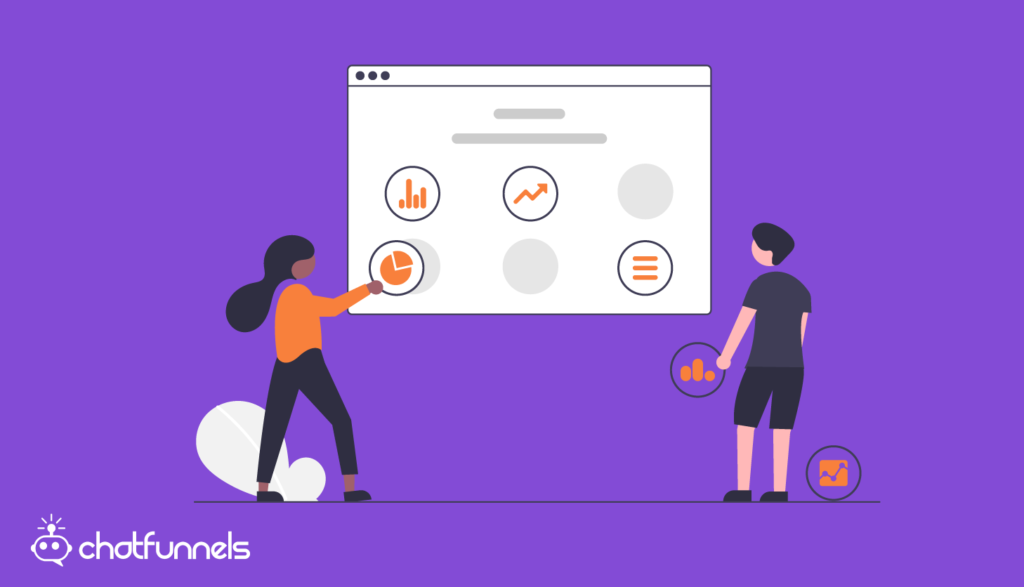What Is Account-Based Marketing?
Account-based marketing (ABM) is shifting from marketing to a specific person to marketing to a whole account/buying committee. It includes providing different messages and tactics for each person involved in the buying process, tailoring your approach to address the specific needs and interests of each key decision-maker. Instead of targeting an entire market, you market to particular accounts, ensuring a highly personalized and effective engagement that resonates with all stakeholders in the decision-making process.
Instead of marketing to everyone and hoping ideal accounts come to you, you must search out the ideal accounts and market directly to them in a personalized and strategic manner. Account-based marketing is one of the most time-efficient ways to market your service or product. According to a study by ITSMA, 87% of B2B marketers reported that account-based marketing strategies outrank all others in terms of ROI.
What Is Conversational Marketing?
Conversational marketing is the optimal marketing strategy for driving engagement. At its core, conversational marketing is targeting customers by having direct, one-on-one conversations with them, whether that’s through email, social, phone, or intelligent chatbots.
The use of chatbots on your site is the most effective way to optimize your conversational marketing strategies. In addition, it allows for real-time engagement, which in turn promotes faster lead conversion, resulting in increased customer satisfaction and higher conversion rates.
Conversational marketing with chatbots differs from traditional marketing in that instead of reaching out to customers to try to get them to your site, you engage right then and there with customers who are already on your site. It allows you to engage with them the moment their interest is piqued.
Account-Based Marketing vs. Inbound Marketing
Inbound marketing has been the main strategy for years. It is all about trying to address and solve customers’ pain points by offering valuable content that pertains to their specific needs. Account-based marketing is different in that it’s about the entire customer journey, not just about bringing in customers initially. It’s also about making customers feel understood by providing them with value in a personalized way.
The customer journey consists of marketing, sales, and customer management. With account-based marketing, each step of the customer journey needs to involve high levels of personalized engagement. You don’t want customers feeling lost in the process. As a customer makes their way down the customer journey, there needs to be a smooth transition and hand-off from each team. Marketing, sales, and customer support teams need to be reaching out and engaging with the customers.
To break it down in the simplest way, inbound marketing is creating content that pertains to your customer’s needs, while account-based marketing is targeting individuals from specific accounts in a personalized way. This helps lead potential customers to further engage with your company through various tactics such as personalized campaigns, targeted emails, social media engagement, and chatbots.
5 Benefits Of Account-Based Marketing (ABM)
The major benefits of account-based marketing are faster pipeline growth, higher close rates, larger average deal sizes, greater customer retention, and further alignment between sales, marketing, and customer support.
1. Faster Pipeline Growth
Account-based marketing (ABM) leads to faster growth of your pipeline. On average, 83% of companies have seen a positive impact on pipeline growth when implementing account base marketing. The sales cycle will speed up because it involves more personalized interactions between the customer and your company. Account owners can be directly routed into conversations with the accounts.
2. Higher Close Rates
You will start to see a higher percentage of your leads converting. You will be spending less time marketing and trying to sell to people who are not a great fit for your product, and more time targeting those who are a perfect fit. Your leads will be more qualified and therefore more of them will convert. In a study conducted by SiriusDecisions in 2017, 66% of respondents experienced 20% better close rates with these new business strategies. The reason is that the accounts you focus on are your ideal customers, not just random people, which inevitably leads to higher close rates.
3. Larger Average Deals
The size of your average deals will be larger because your customers will be able to quickly see the value in using your product since you’ll have more personalized messaging and content. Initially, people may be hesitant to jump right in and purchase your premium package because they are unfamiliar with your product and just want to dip their toes in the water. With account-based marketing (ABM), they will better understand the value your product offers them specifically and know exactly what they are getting into. That eliminates any hesitation on the part of the customer that comes from a lack of education about your product.
4. Greater Customer Retention
Account-based marketing (ABM) leads to greater customer retention because more time is spent developing personal relationships with each member of the buying committee of each specific account. Open communication with customers is the #1 most important factor in customer retention. Not only does it build trust, but it allows the customer to feel heard and appreciated.
5. Aligns Sales, Marketing, and Customer Support
Everyone is always talking about aligning sales and marketing. There is a long-standing battle between the two teams. Marketing blames sales for not closing all the leads they are providing, and sales claims they were horrible leads. Account-based marketing (ABM) leads everyone to focus on the individuals of each account, which will unify your teams on all fronts. ABM is a great play, but sales and customer support are never involved in it. ABM requires the help and support of each of your teams.

Types Of Account Based Marketing
There are two emerging types of account-based marketing (ABM):
1. Strategic Account-Based Marketing
This focuses on the most strategic accounts. It involves teams who are experts on the accounts and who engage with them in personalized ways across all channels. It involves the most individualized engagement, which in turn creates the strongest customer relationships.
However, this level of extreme personalization and attention given to these accounts, realistically, can only be done with tens of accounts. On the other hand, scaled account-based marketing can be implemented across hundreds or thousands of accounts.
2. Scaled Account-Based Marketing
Compared to strategic account-based marketing, scaled account-based marketing is more marketing-led. With a scaled ABM approach, you deploy ABM strategies to segmented accounts rather than to a target audience.
How To Implement Account-Based Marketing
Define Target Accounts/Target Groups: Your company needs to strategize and decide which accounts have the most potential. Remember, the whole point of account-based marketing is reaching out to ideal customers and engaging with them in personalized ways. You and your team need to sit down and discuss what your target accounts and groups are and strategize on what type of content and messaging will appeal to them.
Roll Out A Strategic Strategy: To get started, begin with the top 10-15 most important accounts. You want to start here because not only will it bring in the most revenue, but it will help you figure out how to make your account-based marketing strategies work.
Roll Out A Scaled Strategy: Once you’ve mastered strategic account-based marketing, then you can move on to scaled account-based marketing. Take everything you learned from your one-to-one strategies and scale it in a personalized manner. This is where segmentation comes into play.
Optimize Your Account-Based Marketing Strategies: The most important aspect is to continue to engage in meaningful ways. No one likes a company that markets by throwing out content that isn’t even relevant. Whether you engage with them through phone calls, SMS, emails, or chat, your content needs to offer value and be useful by solving relevant problems. Follow up with personalized, targeted campaigns once they’ve left your website.
Pitfalls of Account-Based Marketing Implementation
The biggest pitfall we have seen with account-based marketing is the initial implementation. People struggle to shift from focusing on one individual to focusing on multiple individuals of a single account. For years, people have ignored the buying committee and focused only on one member of the buying committee. Nowadays, you have to take into account everyone involved in the buying process in order to increase close rates. Even though it may require an upfront time investment, it is worth it to stick it through and fully implement account-based marketing.
One common pitfall is the misconception that account-based marketing is solely the responsibility of the marketing team. In reality, it’s a multifaceted approach that necessitates collaboration between marketing, sales, and customer support. These teams play distinct yet vital roles at different stages of the account-based marketing journey.
When account-based marketing is viewed as a collective effort, it leverages the synergy between these teams, each contributing their expertise. Marketing crafts personalized content, campaigns, and strategies. Sales deploys these materials and nurtures client relationships, while customer support provides post-sale engagement and assistance. To ensure success, alignment and commitment from all teams are crucial, as they collectively deliver consistent, impactful experiences throughout the customer journey. This approach enhances lead generation, conversion rates, and long-term customer satisfaction, making account-based marketing a team endeavor.
Recap of Account-Based Marketing
Consumers nowadays don’t want to waste their time. In theory, they know what they want, but oftentimes are unaware of the true value your product/services can offer them. With account-based marketing, you will be able to focus on target accounts and have real conversations with them in order to lead them to conversion.
Account-based marketing can demand a significant amount of initial implementation and coordination. However, it’s essential to recognize that the journey to success in this strategy can be both rewarding and transformative. When you commit to account-based marketing and ensure that your entire team is aligned with this approach, the potential rewards become even more evident and worthwhile. What makes account-based marketing particularly rewarding is its capacity to deliver highly targeted, personalized interactions that resonate deeply with your target accounts. As your team collectively embraces this strategy, the level of personalization and alignment with the specific needs and pain points of each account increases, resulting in more meaningful engagements and higher conversion rates
Target And Engage With Your Ideal Customer
If you’re seeking a powerful method to elevate your account-based marketing strategies, Signals offers an innovative solution. With Signals, you can not only identify and analyze visitor behavior but also create highly personalized engagement flows tailored to each customer’s unique needs and preferences. This capability allows you to engage with your visitors in real time, providing a dynamic and responsive experience, or set up alerts to promptly identify when an ideal customer lands on a specific page. By harnessing the potential of Signals, you gain the opportunity to craft personalized and highly effective engagement strategies, ultimately driving more prospective customers into your sales pipeline and bolstering your conversion rates. Don’t miss the chance to explore how Signals can be the key to expanding your sales pipeline – click here to learn more and unlock its potential!
READ MORE
Start seeing your Buyers' signals
Signals is helping companies automate, grow, and close sales pipeline with industry-leading predictive intent scoring, lead generation, and real-time engagement.






















